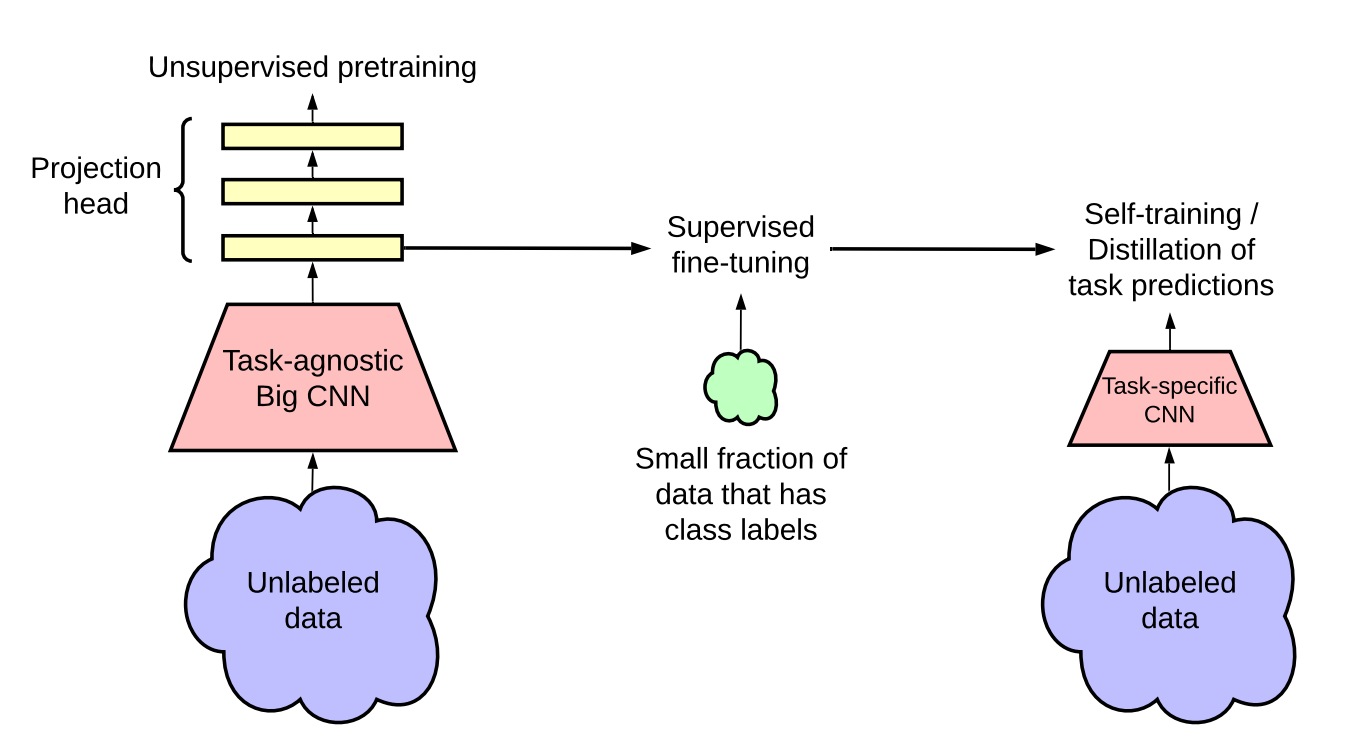
Learn how to learn without labels.
Contrastive learning is a machine learning technique used to learn the general features of a dataset without labels by teaching the model which data points are similar or different.
Let’s begin with a simplistic example. Imagine that you are a newborn baby that is trying to make sense of the world. At home, let’s assume you have two cats and one dog.
Even though no one tells you that they are ‘cats’ and ‘dogs’, you may still realize that the two cats look similar compared to the dog.
By merely recognizing the similarities and differences between our furry friends, our brains can learn the high-level features of the objects in our world.
For instance, we may subconsciously recognize that the two cats’ have pointy ears, whereas the dog has droopy ears. Or we may contrast (hint-hint) the protruding nose of the dog to the flat face of the cats.
In essence, contrastive learning allows our machine learning model to do the same thing. It looks at which pairs of data points are “similar” and “different” in order to learn higher-level features about the data, before even having a task such as classification or segmentation.
Why is this so powerful?
It’s because we can train the model to learn a lot about our data without any annotations or labels, hence the term, SELF-supervised learning.
In most real-world scenarios, we don’t have labels for each image. Take medical imaging, for instance. To create labels, professionals have to spend countless hours looking at images to manually classify, segment, etc.
With contrastive learning, one can significantly improve model performance even when only a fraction of the dataset is labeled.
Now that we understand what contrastive learning is, and why it’s useful, let’s see how contrastive learning works.
In this article, I focus on SimCLRv2, one of the recent state-of-the-art contrastive learning approaches proposed by the Google Brain Team. For other contrastive learning methods such as Facebook’s MoCo, I recommend reviewing the following article.
Fortunately, SimCLRv2 is very intuitive.
The entire process can be described concisely in three basic steps:
- For each image in our dataset, we can perform two augmentation combinations (i.e. crop + resize + recolor, resize + recolor, crop + recolor, etc.). We want the model to learn that these two images are “similar” since they are essentially different versions of the same image.
- To do so, we can feed these two images into our deep learning model (Big-CNN such as ResNet) to create vector representations for each image. The goal is to train the model to output similar representations for similar images.
- Lastly, we try to maximize the similarity of the two vector representations by minimizing a contrastive loss function.
Over time, the model will learn that two images of cats should have similar representations and that the representation of a cat should be different than that of a dog.
This implies that the model is able to distinguish between different types of images without even knowing what the images are!
We can dissect this contrastive learning approach even further by breaking it down into three primary steps: data augmentation, encoding, and loss minimization.
1) Data Augmentation
We perform any combination of the following augmentations randomly: crop, resize, color distortion, grayscale. We do this twice per image in our batch, to create a positive pair of two augmented images.
2) Encoding
We then use our Big-CNN neural network, which we can think of as simply a function, h = f(x), where ‘x’ is one of our augmented images, to encode both of our images as vector representations.
The output of the CNN is then inputted to a set of Dense Layers called the projection head, z = g(h) to transform the data into another space. This extra step is empirically shown to improve performance [2].
If you are unfamiliar with latent space and vector representations, I highly recommend reading my article that intuitively explains this concept before continuing.
By compressing our images into a latent space representation, the model is able to learn the high-level features of the images.
In fact, as we continue to train the model to maximize the vector similarity between similar images, we can imagine that the model is learning clusters of similar data points in the latent space.
For instance, cat representations will be closer together, but further apart from dog representations, since this is what we are training the model to learn.
3) Loss Minimization of Representations
Now that we have two vectors, z, we need a way to quantify the similarity between them.
Since we are comparing two vectors, a natural choice is cosine similarity, which is based on the angle between the two vectors in space.
It is logical that when vectors are closer (smaller angle between them) together in space, they are more similar. Thus, if we take the cosine(angle between the two vectors) as a metric, we will get a high similarity when the angle is close to 0, and a low similarity otherwise, which is exactly what we want.
We also need a loss function that we can minimize. One option is NT-Xent (Normalized Temperature-Scaled Cross-Entropy Loss).
We first compute the probability that the two augmented images are similar.
Notice that the denominator is the sum of e^similarity(all pairs, including negative pairs). Negative pairs are obtained by creating pairs between our augmented images, and all of the other images in our batch.
Lastly, we wrap this value around in a -log() so that minimizing this loss function corresponds to maximizing the probability that the two augmented images are similar.
For more details about the nuances of SimCLR, I recommend checking out the following article.
SimCLR Version 2
It’s useful to note that since the original publication of the SimCLR framework, the authors have made the following major improvements to the pipeline [2]:
- Larger ResNet Models for the Big-CNN Encoder — 152-layer Res-Net, 3x wider channels, selective kernels, attention mechanism.
- More projection heads — use three Dense Layers when transforming intermediate representations instead of two.
Semi-Supervised Learning
When we have very few labels, or if it’s hard to obtain labels for a specific task (i.e. clinical annotation), we want to be able to use both the labeled data and the unlabeled data to optimize the performance and learning capacity of our model. This is the definition of semi-supervised learning.
A methodology that is gaining traction in literature is the unsupervised pre-train, supervised fine-tune, knowledge distillation paradigm [2].

In this paradigm, the self-supervised contrastive learning approach is a crucial ‘pre-processing’ step, that allows the Big CNN model (i.e. ResNet-152) to first learn general features from unlabeled data before trying to classify the images using limited labeled data.
The Google Brain team demonstrated that this semi-supervised learning approach is very label-efficient and that larger models can lead to greater improvements, especially for low label fractions.
NLP Analog
It’s interesting to note that similar self-supervised methods have already been used extensively in the Natural Language Processing realm.
For instance, Word2Vec, an algorithm to convert text to embedded vectors, uses a similar self-supervised approach. In this case, we want the words that are closer to each other in a sentence, to have more similar vector representations.
Thus, we create our ‘positive pairs’ by creating pairs between words within a window. We use a technique called negative sampling to create our negative pairs.
This post contains an intuitive and detailed explanation of the Word2Vec algorithm.
Just like SimCLRv2, Word2Vec allows ‘similar’ words to have more similar vector representations in the latent space, and we can use these learned representations for more specific, downstream tasks such as text classification.
- Contrastive learning is a self-supervised, task-independent deep learning technique that allows a model to learn about data, even without labels.
- The model learns general features about the dataset by learning which types of images are similar, and which ones are different.
- SimCLRv2 is an example of a contrastive learning approach that learns how to represent images such that similar images have similar representations, thereby allowing the model to learn how to distinguish between images.
- The pre-trained model with a general understanding of the data can be fine-tuned for a specific task such as image classification when labels are scarce to significantly improve label efficiency, and potentially surpass supervised methods.
I hope this article provided a clear intuition about what contrastive learning is, how contrastive learning works, and when you can apply contrastive learning for your own projects. Self-supervised learning is truly amazing!
[2] Chen et al. Big Self-Supervised Models are Strong Semi-Supervised Learners, 2020
